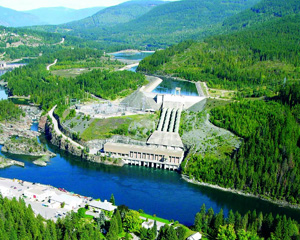BC Hydro – Case Study
FACING THE ELEMENTS: Building Business Resilience in a Changing Climate
AT A GLANCE // |
Location:Vancouver, British Columbia Industry:Utilities Employees (2011):5,800 Revenue (2011):C$4.02 billion |
Key adaptation
|
Adaptation
|
Business BenefitsData and models of climate change available for other industries and companies in B.C. Improved internal and external communication on climate change |
Business ChallengesDifficulty of making business decisions using uncertain future climate projections |
COMPANY OVERVIEW //
VANCOUVER, BRITISH COLUMBIA
www.bchydro.com

Kootenay Canal (photo credit: BC Hydro)
BC Hydro generates between 43,000 and 54,000 GWh a year, depending on prevailing hydrological conditions. Most of the utility’s installed capacity comes from hydropower facilities on the Peace and Columbia rivers. These river basins contributed 30% and 25%, respectively, of the company’s total power production in 2010. Facilities on other river basins contributed 25% of the company’s 2010 electricity output, and the remainder came from conventional thermoelectric plants and electricity purchases.
BC Hydro manages the planning, operation and maintenance of an 18,500km transmission system that connects electricity generation sites in the interior regions of B.C. with the major load centres in the southwest of the province. The company services 1.8 million customers, and projects that electricity needs in the province will grow by 20-40% over the next 20 years.o
In response to the projected electricity supply gap, BC Hydro develops an Integrated Resource Plan that outlines the company’s strategy to meet future demand, including demand-side management, enhancement of existing assets, development of new assets, purchases of new clean power and improved transmission and distribution capacity. The utility has plans to invest more than $460 million toward its Strategic Asset Management Plan objectives in 2011 alone.
HYDROELECTRICITY IN A CHANGING CLIMATE
Though climate change has been strongly recognized as an issue within the energy sector, the industry has mainly focused on the responsibility for greenhouse gas (GHG) mitigation rather than on adaptation of energy supply and services. Because they are low emitters of GHGs and are highly dependent on climate-sensitive water resources hydroelectricity providers have been much quicker to consider the potential impacts of climate change on service provision. Changes in average temperature and precipitation, and increasing climatic variability, are likely to have impacts across the breadth of the hydroelectricity supply chain.
Direct impacts on energy supply and demand are the most obvious: more rapid melting and changes in hydrological runoff patterns will alter generating capacities, and higher seasonal temperatures will likely reduce energy demand for heating in winter while increasing demand for cooling in summer.67
Climate change could also impose a new set of conditions on the design, operation, and maintenance of existing and planned assets and infrastructure. Changes to river flow patterns into reservoirs may make hydroelectric generation planning more difficult to manage, with more frequent potential for flooding and longer summer low-flow periods. Transmission and distribution lines exposed to wind gusts, forest fires, storms, icing, erosion, and storm-related landslides and rock falls, are also potentially more at risk in a changing climate.68
Finally, the complex relationships between the energy sector and other economic sectors (e.g. agriculture, tourism, water) can result in knock-on climate change impacts for hydroelectricity providers. For example, balancing water available for energy generation with demand from other sectors will be increasingly challenging, as rising demand due to population growth may require more water in areas projected to face reduced availability.
ADAPTATION AS PART OF A COMPREHENSIVE CLIMATE CHANGE MANAGEMENT STRATEGY
As a crown corporation, BC Hydro is guided by federal and provincial government regulation concerning climate change, though this has generally focused on energy efficiency and emissions reductions objectives. The company has independently undertaken steps to improve climate resilience as part of a robust risk management approach and as the logical next step after implementing GHG mitigation measures.
As part of the International Council on Large Electric Systems (CIGRE), BC Hydro learns from and shares best practice with peer utilities. The company has been particularly influenced by Hydro-Quebec’s collaboration with partner organization Ouranos to monitor climate change data and develop a climate change adaptation strategy.
BC Hydro developed a comprehensive Climate Change Strategy in 2009. While the first part of the Strategy mainly relates to reduction of GHG emissions from sources of electricity generation and corporate operations, the last part focuses on consideration of adaptation in corporate and project risk management processes. The Strategy includes adaptation actions ranging from collaborative research on impacts and corporate climate risk assessments, to practical changes that help to manage climate risks operationally.
BC Hydro collaborates with the Pacific Climate Impacts Consortium (PCIC) and the Western Canadian Cryospheric Network (WC2N) to study climate change impacts on the hydrology of B.C.69 Since 2007, the company has invested almost $2.5 million in research on the historical and projected runoff of B.C.’s watersheds, with the goal of understanding changes to the hydrological regime in which BC Hydro will operate in the future. The PCIC has produced an overview study of historical climate trends in B.C., as well as river-specific hydrological impacts of climate change on provincial water resources.70 This research program focuses on future risks to hydroelectric generation capacity due to climate change, but the company is actively assessing and managing other potential risks.
For example, BC Hydro has also conducted climate risk assessments to identify climate change impacts on assets and infrastructure. During the assessment phase, the company identified all likely climate change impacts on its distribution and transmission grid, and estimated the potential increase in outages and financial consequences if no action were taken. Drawing on climate model projections from freely accessible sources such the Intergovernmental Panel on Climate Change (IPCC), BC Hydro used a downscaling method to produce regional climate scenarios that help the company to optimize transmission and distribution operations. This method helps to determine the best allocation for existing assets, and decide whether new resources are needed under a range of future climate scenarios.
BC Hydro has also taken steps to protect its transmission lines. The company makes use of research carried out by the University of Alberta and the University of British Columbia to gather data on potential changes in future wind speed and direction, icing loads and precipitation to assess impacts on transmission lines. BC Hydro has modified maintenance regimes and line design standards to increase their resilience to wind and ice loads, exceeding the current Canadian standard requirement.71 BC Hydro’s research and development department is exploring the potential for new corrosion-resistant materials that would extend the lifetime of new transmission lines in a future climate.
Finally, BC Hydro supported the work of the Future Forest Ecosystems Scientific Council led by the UBC Dean of Forestry, through a focused three-year study to assess climate change impacts on forest and other land cover, and the economic, environmental and social resilience of regional planning, public interest, and First Nations and Métis communities in the South Selkirk area of B.C.
BENEFITS AND/OR CHALLENGES
The biggest challenge faced by BC Hydro in its efforts to adapt is the difficulty of implementing operational change on the basis of uncertain climate model projections. Some key climate variables for this sector, such as local wind direction and intensity, remain very difficult to predict using climate models, and this constrains the company’s ability to take account of changes in wind in the design and development of new transmission lines. However, the company is learning to deal with the uncertainty associated with climate projections. By gaining a thorough understanding of the limitations of climate models, BC Hydro can assess how the currently available climate and hydrological scenarios can be applied in the existing planning process, with some measure of the uncertainty associated with the projections.
The main benefits of the company’s work on adaptation include a significant improvement in communication on climate change, and knowledge of potential impacts to the business. Externally, the company has engaged more actively with its customers and stakeholders on climate change issues, and believes that it serves them better as a result. The 2011 Power Smart Forum held with more than 1,500 key customers of BC Hydro had “Climate Adaptation and Resiliency” as its theme, with the objectives to build upon knowledge transfer and research to support customer, government and industry efforts to leverage shared understanding and action on this emerging business issue. Internally, the Climate Change Strategy empowers employees and allows business units to appraise and assess changing needs and risks.
NEXT STEPS
By December 2012 BC Hydro intends to present an Integrated Resource Plan to the Ministry of Energy, which will demonstrate how the utility expects to meet the projected increase in demand for electricity.72 The plan will include an in-depth look at mitigation measures, but adaptation is increasingly being emphasised in the Plan’s implementation phase.
PERSPECTIVES ON GOVERNMENT ROLES
BC Hydro emphasizes the critical role of government in supporting adaptation research and developing practical tools and guidance for business. The B.C. provincial government is a founding member of the Pacific Climate Impact Consortium (PCIC), along with BC Hydro, and in 2008 it provided significant sustaining funding to PCIC through an endowment to the University of Victoria. The Canadian Foundation for Climate and Atmospheric Sciences (CFCAS) funding program supported much of the work done by WC2N (in collaboration with BC Hydro) on glacier studies in BC.
[o] This load forecast is based on socio-economic factors and rolling 10-year average Heating and Cooling Degree Days.
[67] Ebinger and Vergara 2011
[68] Toth and Gurney 2008
[69] Smith 2011
[70] Pacific Climate Impacts Consortium ND
[71] Toth 2011
[72] BC Hydro ND









































